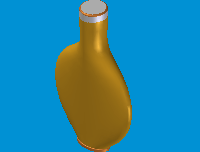
SeGuruCool
The Largest Independant Solid Edge Resource Outside UGS PLM

SeGuruCool The Largest Independant Solid Edge Resource Outside UGS PLM |
|
www.oocities.org/SeGuruCool  segurucool @ indiatimes.com segurucool @ indiatimes.com |
|
|
|
The BlueSurf Per Solid Edge help, a BlueSurf Constructs a surface using existing sketches or part edges. Further, at a minimum, you must define two cross sections or one cross section and one guide curve. And no need to go any further. The minimum conditions for the BlueSurf spell magic. |  |
|
The Birail Magic The BlueSurf is an awesome tool by itself. Let it roll along a birail and it will workout wonder surfaces. |
|
What is a Birail ? A BlueSurf creates a surface using cross-sections and guide-curves. The cross-sections and the guide-curves can be open or closed profiles. When cross-sections travel along two guide-curves, the guide-curves are called birails. The cross-sections and guide-curves must be well connected and this is the basic condition for a BlueSurf. This method allows you to create complex organic surfaces using just two rail curves (birails) and two profile curves. |
|
Under The Hood The curves for the BlueSurf in step 1 are shown in figure besides. The cross-sections (red color) are open. see figure. They can be closed too. On the other hand, the guide-curves (birails) are always open profiles. Also, the birails can be non-striaght curves which they normally are, and you will see this in the examples to follow. |  |
|
Squeeze Bottle Keeping in mind that you are to use only two cross-sections and two guide-curves (birails), lets see what all objects can be created. Look at the bottle shown in figure. |  |
|
The First Cross Section The first cross-section is a circle. Note how the cross-section is connected to the birails. |  |
|
The Second Cross Section The second cross-section is an ellipse. Also, the shape of the birails can be seen towards both the ends. Using these four curves, you can have a bottle in place. To read an indepth tutorial on how to create this bottle, Click Here. |  |
|
HairDryer Handle Take another example of a hair-dryer handle. See figure. |  |
|
HairDryer Handle - Under The Hood The cross-section and the birails are as shown in figure. And a severely indepth tutorial on how to create the complete hair-dryer wiht the handle and more... Click Here. |  |
|
Door-Knob By now you must have got a fair idea of how birails look and work. And if you have started getting a feeling that the birails are pretty straight, then think again. Have a look at the door knob shown in figure. Try to figure out what could be the cross-sections and the birails. |  |
|
Door-Knob - Under the Hood The red circle on the left and the small ellipse on the right end are the cross-sections. The other two white curves (bent like hell) are the birails. Keep admiring the complexity or the organicity of the surface formed. |  |
|
The Birail Magic So the next time you have a complex organic surface to construct, do not panic. Vizualize the surface as two cross-sections and let them roll along the magical birails... |  |
Tushar Suradkar  segurucool @ indiatimes.com segurucool @ indiatimes.com |